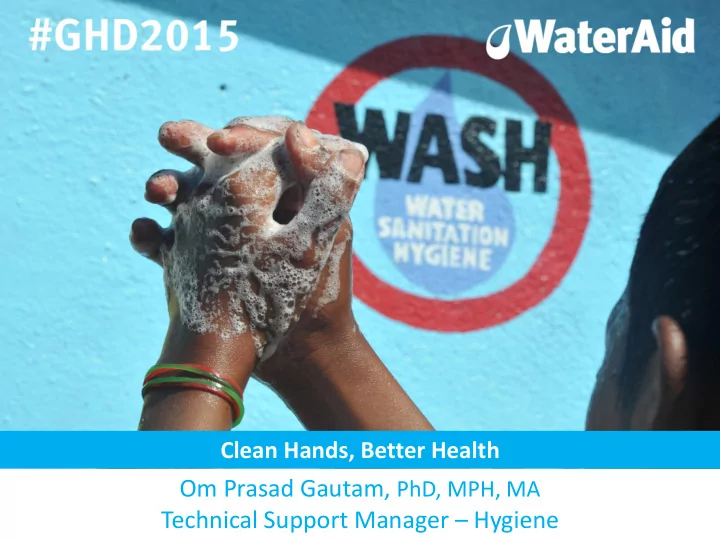

Clean Hands, Better Health Om Prasad Gautam, PhD, MPH, MA Technical Support Manager – Hygiene
Where we work? WA is an international WASH focused development organisation working in 26 countries around the world: Asia, Africa and Pacific region
Our vision is a world where everyone, everywhere has safe water, sanitation and hygiene
Improve hygiene Hands may not be washed Food continue to be polluted behaviours WA understands that unless the Toilets may not be used Water continue to be polluted benefits of good hygiene is fully realised and ingrained as a social norm Dignity will be compromised
Target settings for handwashing Households/communities Schools Health care Policy settings
Target groups “ My baby has worms. She often has vomiting and diarrhoea. I walk 2 km to this water point. This water is free but it breaks down two to three times a year”. Different target groups in different settings
Design Hygiene Intervention Assessment and or Formative Research 1. Hygiene 6. Financing behaviours / practices 5. Hygiene policy / advocacy 2. Presence of Institutional mechanism 4. Technical Programme design, Sustainability 3. implementation & Environmental sustainability Determinants D eliver and monitoring E valuate (baseline, follow-up, sustainability assessment)
Handwashing intervention focus Sustaining Motivating people practices in key (Knowledge ) moments Creating social Handwashing norms facilities Behavioural products (soap, water )
WaterAid and partners use multiple approaches to promote handwashing behaviours
Child-to-child approaches
Child-to-child: school curriculum development
Group events/mothers group events Social drama
Handwashing facilities
Puppet shows
Cultural events and theatre
Handwashing demonstration
Using social and commercial marketing techniques
Hygiene promotion through routine immunisation Fan Mirror Bib
WASH new users by year (n=26 CPs) 6,000,000 Each year, ~ 4 million people 5,136,064 exposed with hygiene 5,000,000 intervention through WA Number of people 4,000,000 programme 3,067,330 3,014,060 2,799,606 3,000,000 2,144,921 1,911,135 1,918,801 1,873,665 2,000,000 1,673,410 1,000,000 - 2012-13 2013-14 2014-15 Hygiene Water Sanitation
Bangladesh PIMS 2014: handwashing facilities in use, with soap of any kind (n=2,849 HHs): an example
Global Handwashing Day: breaking records in India, 2014
Behaviour change: an example from food hygiene trial 5. Water 1. Cleanliness of child treatment food serving utensils using ash/soap Sequentially targeted 5 behaviours: 239 HHs with young children 2. Handwashing with soap before feeding child (by mother) and before eating (by child) 4. Thorough re-heating of leftover/stored food 3. Proper storage of cooked ( Maintain re-heating temp food in container with tight lid at least at 70 0 c)
Disgust Affiliation Status Nurture Delivery (D): 6 + 6
Innovation and creativity in behaviour change: changing settings The script in peoples’ heads The physical infrastructu re and the objects Social norms belonging to that setting
Outcomes (intervention trial) 70 Intervention (n=120) Control (n=119) 60 Mothers practicing all key behaviours (%) 50 3 months intervention 43 % difference = 42% in intervention group 40 30 Effect size : 42% (difference of 20 differences) (P = 0.020)* 10 2 2 1 % difference = 0% 0 Before (baseline) After (follow-up) Key food hygiene behaviours before and after intervention, by study group Source: Gautam, O et al, 2014
WA’s learning on hygiene promotion • We need to move away from knowledge focused approaches to innovative and creative approaches for creating sustained behaviour change , targeting emotional drivers (nurture, disgust, affiliation, status, comfort etc.), social marketing, and behavioural determinants and settings. • Behaviours basically linked to social norms and settings • Possible to alter multiple hygiene behaviours including HWWS using emotional drivers and changing environment however: – Sustaining behaviours is a big challenge – Ensuring behavioural products is a challenge
WA’s learning on hygiene promotion cont... • Being an expert on WASH does not make us experts on designing innovative package therefore: – Formative research should inform the design process – Using creative process and team is imperative • Hygiene promotion package need to be simple, innovative and also feasible to contextualise for scalability! • Monitoring behavioural outcomes in large scale programming still needs improvement
Thank you!
Recommend
More recommend